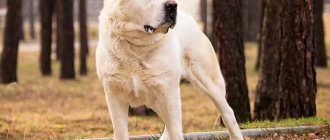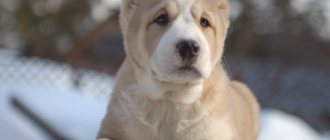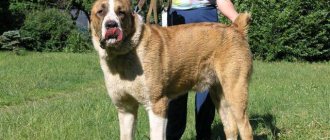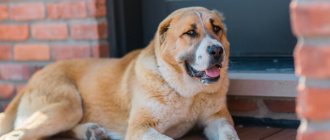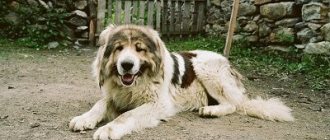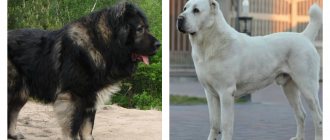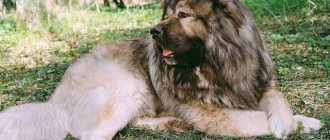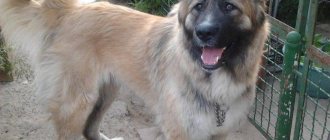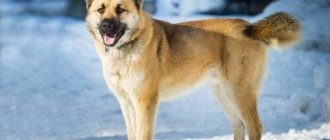- Height at withers: Males 70 - 95 cm; Females 65 – 78 cm
Weight: Males 60 -100 kg; Females 45 – 65 kg
Note: male dogs must have two full-fledged, well-developed testes, completely descended into the scrotum.
Disadvantages: small deviations from the standard requirements that do not violate the overall impression and do not affect the working qualities of the Alabai (Central Asian Shepherd Dog) are acceptable.
Alabai has a hard and straight coat, with a fairly thick undercoat. Thanks to its thick skin, it is protected from enemy bites.
Alabai character
The Central Asian Shepherd is similar in character to the Caucasian Shepherd.
Since for quite a long time the Alabais developed the ability to stand up for themselves well, aggression towards their own kind became entrenched at the genetic level.
Alabai will be ready to “tear apart” any foreign dog that comes into his field of vision, but he treats his brothers who are in the same yard with him quite calmly. Despite its well-developed security qualities, with proper training, it will never attack a person.
The main character traits of the Alabai are confidence, endurance and courage. It combines fighting skills and calmness, and is one of the most intelligent breeds in the world. Since the Central Asian Shepherd is characterized by its willfulness, it requires professional training at an early age and socialization. The reaction to stimuli in a Central Asian is quite long, and in order to distract him, it is necessary either to eliminate the provoking factor or to attract attention with another stimulus.
If you are looking for an unpretentious and reliable friend, a guard for your property, she will be just perfect. Alabai combines character traits similar to the Great Dane and mountain herding shepherd dogs. They are independent and proud, self-confident, distrustful of strangers, and at the same time they very subtly sense fluctuations in the owner’s mood.
Breed characteristics
The Central Asian Shepherd is distinguished by its large size and thick coat. Its average height is from 60 to 70 cm at the withers, and its weight is from 45 to 55 kg. There are also larger representatives of Alabais.
Head
Massive, proportional to the overall physique. Its shape is close to the rectangular type. The back of the head is pronounced, the stop is moderate.
Muzzle
Wide, practically not tapering towards the nose. His lobe is massive, but does not protrude beyond the general contour of the head, and is black. The jaws are massive and wide, thanks to which they have a strong grip. A scissor bite is considered normal.
Ears
Low set, pendulous, triangular in shape
Neck
Medium length, muscular. A special feature of the shepherd dog is its pronounced dewlap.
Breast
Wide, elongated, gradually widening towards the back. The lower back drops to the level of the elbows.
Paws
Straight, strong with well-developed muscles.
Tail
He is set high and wide. Before docking, it is crescent-shaped. Its tip can be curled into a ring.
Color
Any color is allowed, except blue and brown. The brindle alabai and fawn color are highly valued.
There is a regulation that sets out what the CAO should look like. Any difference is analyzed by experts to decide whether the dog is admissible for participation in a competition or exhibition.
Alabai (Central Asian Shepherd) care and maintenance
Alabai puppies play on the sand
Keeping and caring for the Central Asian Shepherd does not require much labor or effort. The wool is resistant to dirt and will look well-groomed and clean even in the absence of regular care.
Alabai sheds quite heavily in the spring, then continues to shed throughout the year, but not so intensely. With regular separation of dead fur, the amount of shedding in the house will be significantly reduced. It is recommended to brush the Central Asian Shepherd outside, in an open space.
It is important to inspect and clean your ears on time. It is recommended to trim the claws 2 times a month. Alabai is a large breed and is prone to joint diseases. Therefore, from puppyhood, make sure that she receives a properly balanced diet. The optimal condition for keeping a Central Asian Shepherd dog would be a private house with an aviary.
Alabai tolerates heat and cold quite easily and is not fussy about food. Alabai males are distinguished by their independence, but females have a calmer character. Therefore, it is recommended to keep individuals of different sexes in the same territory. They need good exercise and long walks.
Who is better to have: a Caucasian or an Alabai?
Alabai (Central Asian Shepherd): dog breed
An adult representative of any of these breeds will make an excellent watchdog. But, in addition to its service characteristics, when choosing, you should also take into account the features of caring for these animals. For example, Alabai wool does not require special care, it does not tangle, and is easy to tidy. But Caucasians need regular brushing, at least three times a week. In addition, releasing such an animal into the fresh air in an urban environment is always associated with certain difficulties, since Caucasians do not like to walk under water. So, all other things being equal, it is worth thinking about getting an Alabai.
Alabai food
In the photo Alabai mother with children
The Central Asian Shepherd requires a balanced diet with the required amount of vitamins and minerals.
The main rules for proper feeding of Alabai are as follows:
- The presence of two bowls (enamel or aluminum) - with clean water and for food;
- The bowls are placed on a special stand where the height is adjusted. He should reach up to eat food, and not lower his head down;
- Dry food or natural food is only high-quality and fresh, food at room temperature;
- Alabai should always and at any time have access to a bowl of water;
- Feed at the same time. If you haven’t finished eating, the bowl of food is removed; do not allow yourself to overeat;
- Do not give tubular bones or sweets.
Basic rules for proper nutrition in Alabai:
- Since pork fat is poorly absorbed, it is not recommended to give pork;
- The best meats to give Alabai are veal and beef. Give chicken with caution - watch for allergies and avoid the inclusion of tubular bones;
- You can replace part of the meat with offal, but do not exclude meat completely;
- Alabayas often cook soup - first the meat is boiled, then cereal is added to it and left to cook until half cooked. She should not eat more than two liters at a time;
- The diet includes sea fish;
- Cereals - rice, buckwheat and oatmeal;
- If there is a need to switch to a new food, then this must be done gradually, adding new food daily for 6-8 days;
- Fermented milk and dairy products, cottage cheese, and eggs must be included in the diet.
Choosing a puppy
Given the multiple intraspecific varieties, a number of sellers using the Internet as a marketplace offer a variety of puppies, claiming to be from different breeds. Beautiful and original terms are used, it is described how the Alabai differs from the Asian, but there is a high probability that behind the “beauties” there are puppies obtained from interbreed mating.
A breeder who is really involved in breeding Asians, when asked: what is the difference between the Central Asian Shepherd Dog and the Alabai, will immediately answer that these are different names for the same breed . Therefore, if you want to buy a purebred dog, you should contact nurseries where there are no difficult to pronounce and newfangled names.
Accordingly, the differences between the Alabai and the Central Asian Shepherd are only in the name and, when purchasing a puppy, you can “introduce” it as familiar in any way: the choice depends on the taste and preferences of the owner.
Training the Central Asian Shepherd
Alabai photo in the enclosure
You need to devote at least 20 minutes a day to training a Central Asian Shepherd. All family members take part in raising the alabai, observing the general rules. Despite the fact that the Alabai is a traditional workhorse, it needs proper training.
Already by the age of 9 months, take care of education and knowledge of commands, so training begins at 3 months of age. For an Asian, the most suitable is imitation training, imitation, as well as the operational method (motivational training). Great importance is given to the formation of a number of needs in him - positive emotions, the need for play, social needs (the need to communicate with animals, family members and the owner).
When training the Alabai, it is important to remember that he is vindictive and touchy. Applying harsh measures to them is simply inappropriate. It is not recommended to constantly suppress and scold your pet, otherwise this will lead to loss of contact with it.
In the photo there is an alabai for protecting a private house
The most important thing in training an Alabai is to develop obedience and compliance with commands. Just don't achieve this by beating.
The most important thing is that she should calmly give away the food. Teaching the “sit” command is quite simple. But with the commands “stand” and “lie down” the situation is more complicated. It is mandatory to follow the commands “come to me” and “nearby”. Having given an Asian a command, it is necessary to ensure its execution. It is important to teach him not to react to extraneous stimuli; to do this, walk him in different places, changing the walking route each time.
A separate and important point in Alabai training is control over aggressive behavior towards other animals.
It is extremely important to socialize your puppy to other breeds at an early age. Do not forbid communicating with your own kind. If manifestations of unreasonable aggression towards other pets are noticed, it is necessary to strictly punish them. Proper upbringing and care of an Asian will make him a wonderful friend and reliable guard.
Photo of Alabai or Central Asian Shepherd Dog
Historical reference
Central Asian Shepherds belong to the Molosser group. Ancient Egyptian and Assyrian dogs are considered their ancestors. Among the ancestors of the breed were Mongolian shepherd dogs and Tibetan mastiffs.
Alabai was finally formed about four thousand years ago. Selection was carried out naturally. Dogs guarded caravans of nomads and herds of shepherds. By protecting property from steppe wolves, the strongest individuals survived.
Wolfhounds were distributed throughout Central Asia. From Afghanistan to the Southern Urals. From the Caspian Sea to China.
Turkmen wolfhounds of pure blood are the national treasure of Turkmenistan; they are prohibited from being exported outside the country.
In the 18th century, biologists became interested in Turkmen shepherd dogs. Scientists tried to breed a more docile version by crossing. The attempts were in vain.
Origin story
The Central Asian Shepherd Dog (CAO) is an indigenous breed from the countries of Central Asia that has existed for over 4 thousand years. Asian dogs are endowed with a developed territorial instinct. For many centuries they protected caravans and houses from robbers, and were also actively used by cattle breeders to protect their herds. The fearless, intelligent and noble animal quickly became a national treasure, which resulted in the emergence of alternative names:
- tobet (dog on a hill) – a Kazakh version, noting the peculiarity of tracking predators (the dog was located on the top of a hill, opening a wide viewing angle);
- alabai (variegated and rich) - a Turkmen version based on the variegation of color and the richness of the coat;
- Buribasar (wolfhound) - an Uzbek version that celebrates fighting skills that allow one to emerge victorious in a fight with wolves.
Alabai and Tibetan Mastiff puppy (Tibetan Alabai) is different from the Central Asian Shepherd Dog
Thus, the Central Asian Shepherd and Alabai are different names of the same breed: SAO is the official one, and Alabai is the national one.
IMPORTANT! The official FCI standard for Central Asian Shepherd Dogs was adopted in the spring of 1993. The breed was assigned number 335.
In the 30s of the 20th century, breeders intervened in the formation of the breed and violated traditional natural selection. This led to new variations of Asians.
Description of the breed
FCI Standard No. 335 dated October 13, 2010 “Central Asia Shepherd Dog”. Group 2 “Pinchers and Schnauzers, Molossians, Mountain and Swiss Cattle Dogs.” Section 2 “Molossians”.
The FCI standard specifies the dimensions of an adult Alabai: Height at the withers: for a male, at least 70 cm, for a female, at least 65 cm. Larger height is desirable while maintaining harmony of build. Weight: minimum 50 kg for a male, minimum 40 kg for a female.
Central Asian Shepherd: The breed description includes a powerful body, broad chest and back. They are distinguished by a wide, massive head with a flat forehead, a voluminous muzzle with a large black or brown nose. The eyes are set wide and round. Small triangular ears, sometimes cropped - the standard allows both options.
The belly is slightly tucked in. The height at the withers is slightly higher than the height at the rump. The paws are compact and strong.
Tail docking is allowed by the standard; a natural tail has equal value to a docked one.
The coat is coarse, hard, straight, with a thick undercoat. Depending on the length of the guard hair, dogs are distinguished with short hair (3-5 cm), lying all over the body, and with longer hair (7-10 cm), intermediate type, forming a mane on the neck, feathering behind the ears, on the back sides limbs and tail.
The standard allows any color, except for genetic blue, genetic brown in any combination and black-backed.
How long does alabai live? Life expectancy with proper care is, on average, 12-15 years.
Appearance of Alabai
These dogs are characterized by a massive head, similar in shape to a rectangle. The transition from the forehead to the muzzle may seem rough, but this impression is only due to the large brow ridges.
The Alabai's muzzle does not tend to taper towards the nose. Thick upper lips hang slightly, covering a strong and large jaw.
The ears (as well as the tail) are usually cropped in puppyhood, but with long ears the Alabai looks less aggressive and more cute.
Photo 2. Alabais have an article and self-confidence
Ear cropping for Alabais is a voluntary procedure. The breed standard does not oblige this, and at many shows, breeders present Central Asian Shepherds with long ears and a tail.
On the front of the Central Asian Shepherd’s neck there is a “suspension” in the form of a collar, which adds weight and volume to the dog’s already strong neck.
The paws are straight, stand straight and parallel, providing the dog with an easy “cat-like” gait.
The thick coat of these dogs remains just as thick in both short-haired and long-haired representatives. The length of the fur can reach 10 cm.
The breed standard allows for a wide variety of colors. Only blue and brown shades are excluded.
This type of shepherd dog can be black, black and white, fawn, red and other colors, including multi-color options in various combinations.
Characteristics, skills and abilities
During their existence, alabai were used mainly to guard livestock, caravans and the owner’s home, being subject to strict natural selection. Difficult living conditions and constant struggle with predators shaped the appearance and tempered the character of this dog, made it strong, fearless, and taught it to use energy sparingly.
In their original habitats, Central Asian Shepherds are used primarily to protect herds from predators, and also as guard dogs. They are characterized by an independent line of behavior; they will not serve because of food. Rather, with a sense of self-esteem, they will take food as a reward for service.
He will not look away when you look closely, but will proudly and calmly look down on you - this is the best characteristic of the Alabai breed. They prefer to think when making decisions and may refuse to carry out commands from their owner that they consider inappropriate.
Alabais are phlegmatic and balanced. They don’t like to show aggression or rush into battle. They will most likely warn you by barking or growling that you should not violate their boundaries. Alabai: characteristics of the breed, reviews indicate that only in rare cases do they turn into ferocious fighters.
Alabai really dislikes drunks and invasion of his personal space.
Asians treat children well, but do not allow free treatment. They communicate very well with their fellow tribesmen, flock together and recognize their place there.
Training. The characteristics of the breed do not allow inexperienced dog breeders to raise and train. Raising an Alabai at home should begin almost from birth under the guidance of a dog handler. By three months, wolfhounds have developed an independent personality and it will be much more difficult to correct an established pattern of behavior.
It is forbidden to cause pain to the alabai. Screams and too sudden movements should be avoided. The dog can get out of control and injure itself.
The Asian should be taught to give food to the owner. This is how the puppy learns who is the leader of the pack. You can’t indulge your pets - they quickly take the reins of power into their paws.
Quite quickly, shepherd dogs begin to follow standard commands. Nevertheless, raising a dog should be entrusted to a training specialist.
Varieties and colors
Depending on the place of breeding and use, such a shepherd dog has differences between representatives of the breed from each other. The types of CAO are shown in the table:
| Alabai | Description |
| Turkmen | Is a native dog. Divided into 2 types: * Turkmen - a relatively small individual that is considered suitable for living in the city; * coplon-leopard. Characterized by significant size, intelligence, willfulness, increased speed of reaction to external stimuli and low sensitivity to pain |
| Caucasian | The breed was developed by crossing with the Caucasian Shepherd Dog |
| Tibetan | A small variation resulting from mixing with the Tibetan Mastiff |
| Turkish | The youngest species of the breed, the history of the origin of its representatives is unknown. Despite the name, this dog is not common in Turkey |
There is also a mountain type - the Turkmen long-haired Alabai. But these dogs are not officially recognized.
The color of the Central Asian Shepherd is varied:
- white;
- grey.
- black;
- ginger;
- brindle.
It is allowed to dilute the main tone with white areas. The fur of dogs that have a brindle color can be yellow, fawn, brown or gray. Sometimes you can find snow marks. This Alabai has a mask of dark wool on its muzzle. Black individuals may have small white, gray, brown or brown markings.
Owner reviews
The owners of Central Asian Shepherds are unanimous in their opinions about the breed. There are the same pros and cons.
Yaroslav, Chelyabinsk. “I am the owner of an adequate representative of this breed with an excellent pedigree. Mukhtar is a faithful friend. A good watchman. Allows children to hang on themselves. I recommend it to those who live in rural areas. Disadvantage: I tend to make independent decisions.”
Eris, Korolev. “The best dog of my life! Big defender. I wasn't afraid to go anywhere with her. A very faithful friend. Rona was level-headed, but had her own opinions. She lived with us for 17 years. It’s been three years since she’s been with us, but I still can’t get a new dog. The Alabaika was too good.”
Slavyana, Khmelnitsky. “A dog is a friend, a guard dog. Alabai is a naturally bred shepherd dog breed. They have high intelligence and endurance. Unpretentious. There are practically no complaints. The only negative is that she is wayward.”
